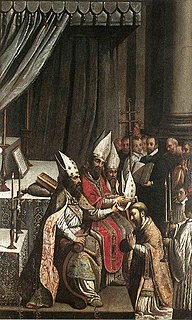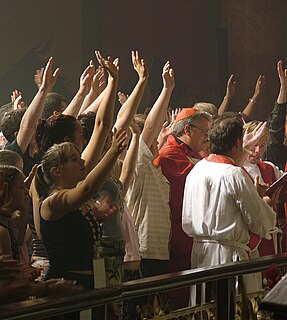Related Research Articles

Apostolic succession is the method whereby the ministry of the Christian Church is held to be derived from the apostles by a continuous succession, which has usually been associated with a claim that the succession is through a series of bishops. Christians of the Roman Catholic, Eastern Orthodox, Oriental Orthodox, Old Catholic, Hussite, Anglican, Church of the East, Moravian, and Scandinavian Lutheran traditions maintain that "a bishop cannot have regular or valid orders unless he has been consecrated in this apostolic succession." Each of these groups does not necessarily consider consecration of the other groups as valid.

The Eastern Orthodox Church, officially the Orthodox Catholic Church, is the second-largest Christian church, with approximately 220 million baptised members. It operates as a communion of autocephalous churches, each governed by its bishops in local synods. Roughly half of Eastern Orthodox Christians live in the territory of the former Soviet Union, most of those living in Russia. The church has no central doctrinal or governmental authority analogous to the bishop of Rome, but the ecumenical patriarch of Constantinople is recognised by all as primus inter pares of the bishops. As one of the oldest surviving religious institutions in the world, the Eastern Orthodox Church has played a prominent role in the history and culture of Eastern and Southeastern Europe, the Caucasus, and the Near East.

Eastern Christianity comprises Christian traditions and church families that originally developed during classical and late antiquity in the Middle East, Egypt, Northeast Africa, Eastern Europe, Southeastern Europe, Asia Minor, the Malabar coast of southern India, and parts of the Far East. The term does not describe a single communion or religious denomination. Major Eastern Christian bodies include the Eastern Orthodox Church, the Oriental Orthodox Churches, the Eastern Catholic Churches, Protestant Eastern Christian churches who are Protestant in theology but Eastern Christian in cultural practice, and the denominations descended from the historic Church of the East. The various Eastern churches do not normally refer to themselves as "Eastern", with the exception of the Assyrian Church of the East and the Ancient Church of the East.
Sola scriptura is a theological doctrine held by some Protestant Christian denominations that the Christian scriptures are the sole infallible source of authority for Christian faith and practice.
Chrismation consists of the sacrament or mystery in the Eastern Orthodox, Oriental Orthodox and Eastern Catholic churches, as well as in the Assyrian Church of the East initiation rites. The sacrament is more commonly known in the West as confirmation, although Italian normally uses cresima ("chrismation") rather than confermazione ("confirmation").

Christian Church is a Protestant ecclesiological term referring to the church invisible comprising all Christians, used since the Protestant Reformation in the 16th century. In this understanding, "Christian Church" does not refer to a particular Christian denomination but to the "body" or "group" of believers, both defined in various ways. A prominent example of this is the branch theory maintained by some Anglicans. This is in contrast to the one true church applied to a specific concrete Christian institution, a majority Christian ecclesiological position maintained by the Catholic Church, the Eastern Orthodox Church, the Oriental Orthodox churches, Assyrian Church of the East and the Ancient Church of the East.

A Christian denomination is a distinct religious body within Christianity that comprises all church congregations of the same kind, identifiable by traits such as a name, peculiar history, organization, leadership, theological doctrine, worship style and sometimes a founder. It is a secular and neutral term, generally used to denote any established Christian church. Unlike a cult or sect, a denomination is usually seen as part of the Christian religious mainstream. Most Christian denominations self-describe as Churches, whereas some newer ones tend to use the terms churches, assemblies, fellowships, etc., interchangeably. Divisions between one group and another are defined by authority and doctrine; issues such as the nature of Jesus, the authority of apostolic succession, biblical hermeneutics, theology, ecclesiology, eschatology, and papal primacy may separate one denomination from another. Groups of denominations—often sharing broadly similar beliefs, practices, and historical ties—are sometimes known as "branches of Christianity". These branches differ in many ways, especially through differences in practices and belief.

Papal primacy, also known as the primacy of the bishop of Rome, is a Christian ecclesiological doctrine concerning the respect and authority that is due to the pope from other bishops and their episcopal sees.

The Evangelical Catholic Church (ECC) was founded in 1976 by former pastors and members of the Lutheran Church—Missouri Synod who were influenced by or interested in Eastern Orthodoxy. Originally a small High Church, Evangelical Catholic denomination, it later became an Independent Catholic Church, though it remained theologically Lutheran. The ECC became inactive in 2009, was refounded in 2014, and disbanded in 2016.
The Evangelical Orthodox Church (EOC), founded on January 15, 1979, is a small Christian syncretic denomination established by former leaders of Campus Crusade for Christ, who, reacting against the freewheeling Jesus People movement, developed their own synthesis of Evangelicalism, Eastern Orthodoxy, and Shepherding Movement principles.

The Charismatic Episcopal Church, more officially known as the International Communion of the Charismatic Episcopal Church (ICCEC), is a Christian denomination established as an autocephalous communion in 1992. The ICCEC states that it is not a splinter group of any other denomination or communion, but is a convergence of the sacramental, evangelical, and charismatic traditions that it perceives in the Church from the apostolic era until present times.

Branch theory is an ecclesiological proposition that the One, Holy, Catholic, and Apostolic Church includes various Christian denominations whether in formal communion or not. The theory is often incorporated in the Protestant notion of an invisible Christian Church structure binding them together.
The Convergence Movement is a Protestant Christian movement that began during the Fourth Great Awakening (1960–1980) in the United States. It is largely a result of the ecumenical movement. The Convergence Movement developed as a syncretic movement among evangelical and charismatic churches in the United States blending charismatic worship with liturgies from the Book of Common Prayer, and other liturgical sources common to Lutheranism, Anglicanism, and Roman Catholicism. Denominational groups forming the Convergence Movement may self-identify as Convergence, paleo-orthodox, Ancient-Future Faith, or Evangelical Episcopal; many Convergence Christian denominations identify with some form of Anglicanism or Episcopalianism.

The term Eastern Protestant Christianity, as well as Oriental Protestant Christianity, encompasses a range of heterogeneous Protestant Christian denominations that developed outside of the Occident, from the latter half of the nineteenth century and yet keeps elements of Eastern Christianity, to varying degrees. Most of these denominations came into being when existing Protestant Churches adopted reformational variants of Orthodox Christian liturgy and worship; while others are the result of reformations of Orthodox Christian beliefs and practices, inspired by the teachings of Western Protestant missionaries. Some Eastern Protestant Churches are in communion with similar Western Protestant Churches. However, Eastern Protestant Christianity within itself, does not constitute a single communion. This is due to the diverse polities, practices, liturgies and orientations of the denominations which fall under this category.
The local churches and the ministry of Watchman Nee and Witness Lee have been the subject of controversy in two major areas over the past fifty years. To a large extent these controversies stem from the rapid increase and spread of the local churches in the United States in the 1960s and early 1970s. In the 1970s they became a target of opposition of fledgling countercult ministries. Unsupported criticisms of anti-social behaviors led to three libel litigations. In addition, some criticized the teaching of Witness Lee on the nature of God, God's full salvation, and the church.
Peter Edward Gillquist was an American archpriest in the Antiochian Orthodox Christian Archdiocese of North America and retired chairman of the archdiocese's department of missions and evangelism. He was chairman of Conciliar Press and the author of numerous books, including Love Is Now, The Physical Side of Being Spiritual and Becoming Orthodox. He also served as project director of the Orthodox Study Bible and from 1997 served as the National Chaplain of the Sigma Alpha Epsilon fraternity.

The Oriental Orthodox Churches are a group of Eastern Christian churches adhering to Miaphysite Christology, with a total of approximately 60 million members worldwide. The Oriental Orthodox Churches are broadly part of the trinitarian Nicene Christian tradition shared by today’s mainstream churches, and represent one of its oldest branches.
The Christian World Liberation Front (CWLF) was a campus outreach at the University of California, Berkeley. It sought to appeal to disenfranchised young people by adopting the mode of dress, methods, and language of the radical counterculture. It was established in April 1969 and dissolved in June 1975. It was considered one of the most prominent Jesus People ministries, partly due to the influence of its underground newspaper Right On.
References
- ↑ Herbel, D. Oliver (2014). Turning to Tradition: Converts and the Making of the American Orthodox Church. New York: Oxford University Press. p. 107. ISBN 9780199324958. OCLC 857743751.
- ↑ Walker, Gordon (September 1983). "Odyssey to Orthodoxy". Again. Vol. 6 no. 3. p. 4.
- ↑ Turner, John G. (2008). Bill Bright & Campus Crusade for Christ: The Renewal of Evangelicalism in Postwar America. Chapel Hill, NC: University of North Carolina Press. p. 137. ISBN 9780807831854. OCLC 5619183701.
- ↑ Stiling, Ruth (May 1980). An Examination of the Evangelical Orthodox Church (MA). Dallas, TX: Dallas Theological Seminary. pp. 17–18.
- ↑ Barth, Steve (November 13, 1979). "Development of Evangelical Church Traced: Twelve Years of Theology Change Moves Away from Anti-Authority". Daily Nexus. Santa Barbara, CA: University of California, Santa Barbara. pp. 1, 3. Retrieved 5 February 2020.
- ↑ Gillquist, Peter (1992). Becoming Orthodox (Rev. ed.). Ben Lomond, CA: Conciliar Press. pp. 29–40. ISBN 9780962271335. OCLC 27034433.
- ↑ Hopkins, Joseph (April 21, 1978). "Schism in the Order". Christianity Today. Vol. 22 no. 14. p. 45.
- ↑ Swartz, David R. (2008). Left Behind: The Evangelical Left and the Limits of Evangelical Politics, 1965-1988 (PhD). South Bend, IN: University of Notre Dame. p. 479. OCLC 436718750.
- ↑ Stiling, pp. 19-20.
- ↑ Gillquist, Peter; Walker, Gordon (October 1987). "Arrowhead Springs to Antioch: Odyssey to Orthodoxy". The Word. p. 7.
- ↑ Thompson, Lloyd R. (1979). A Critical Analysis of the Evangelical Orthodox Church (New Covenant Apostolic Order (PhD). New Haven, CT: Yale Divinity School. pp. 20–21, 102–132.
- ↑ Thompson, pp. 6, 44-45.
- ↑ St. Athanasius Academy of Orthodox Theology, brochure, undated.
- ↑ Jack Sparks, The Mindbenders, 1976; Jon Braun, It Ain’t Gonna Reign No More, 1978; Jack Sparks, The Apostolic Fathers, 1978; Kenneth Berven, I Love Being Married to a Grandma, 1978; Jon Braun, What Happened to Hell?; and Jack Sparks, The Resurrection Letters, 1979.
- ↑ Webber, Robert; Bloesch, Donald, eds. (1978). The Orthodox Evangelicals. Nashville, TN: Thomas Nelson. ISBN 9780840756541. OCLC 4056109.
- ↑ Fester, Joseph H. (1982). The Evangelical Orthodox Church and Its Dialogue with the Orthodox Church in America (M.Div.). Crestwood, NY: St. Vladimir’s Orthodox Seminary. p. 8.
- ↑ Thompson, 35.
- ↑ Stiling, 22.
- ↑ Letter from Peter Gillquist to NCAO churches, January 16, 1978, in Thompson, 41-42.
- ↑ Counts, Bill. "The Evangelical Orthodox Church and the New Covenant Apostolic Order." Berkeley, CA: Spiritual Counterfeits Project, November 2, 1979.
- ↑ Thompson, pp. 84-96.
- ↑ Herbel, pp. 111-113.
- ↑ Walker, "Odyssey to Orthodoxy," p. 10.
- ↑ "Evangelical Orthodox Church" (Press release). Santa Barbara, CA: Evangelical Orthodox Church. n.d.
- ↑ Stiling, pp. 26.
- ↑ "Evangelical Orthodox Join Antiochian Jurisdiction". Theosis. Vol. 9 no. 9. September 1986. p. 8.